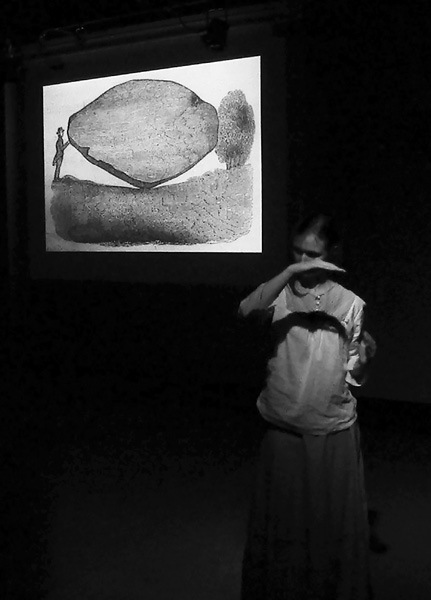
FLORENCE RICE HITCHOCK AND THE THEORY OF THE SOFT EARTH
first performed on October 2, 2015
A.P.E. Gallery, Northampton, MA
performed twice in 2015
SARA SMITH
Candice Salyers, Kathy Couch
Greenfield, MA
sarasmithprojects.com
FLORENCE RICE HITCHOCK AND THE THEORY OF THE SOFT EARTH
SARA SMITH
“Florence Rice Hitchcock and the Theory of the Soft Earth” is a multimedia performance that combines dance with animation and mock documentary. It tells the story of Florence Rice Hitchcock, a nineteenth-century geologist who has visions of twentieth-century science, which she secretly incorporates into her developing Theory of the Soft Earth. Florence is a fictional amalgam of actual historical figures, including Ralph Waldo Emerson, Teilhard de Chardin, Margaret Fuller, Ibn Sina, and others. Candice Salyers performs as Florence.
Florence’s biography and diary entries quote heavily from historical sermons, scientific treatises, and letters and diaries, as well as containing purely invented elements. I spent three years researching a wide-range of distantly related subjects: nineteenth-century geology and Newtonian mechanics, contemporary quantum physics, environmental science, transcendentalism, the history of women’s science education, and 1960s computer animation. We also spent time with geological specimens, using them as the bases for improvisational movement experiments in the studio as Candice worked to embody Florence’s spiritual and scientific contemplation, conflict, and growth. All of the gathered information, images, and discussions were compiled and collaged into a documentary video about Florence’s life (with audio recordings of excerpts from her archive of diaries and letters) and became sources for dance material.
Embedded in Florence’s fictional biography and theory is an idiosyncratic history of scientific and spiritual thought about humans’ relationship to the rest of the world, particularly elements we sometimes think of as more “permanent” than ourselves, like the earth’s crust, the oceans, and the stars. I wanted to create a story that would ask viewers to think of themselves in connection to these other parts of our shared environment, and reflect on this environmental moment. The Theory of the Soft Earth has its roots in nineteenth-century theological science, and stretches to meet our evolving understanding of the role of uncertainty in how the universe functions, and the effects of humans on the earth and other species.